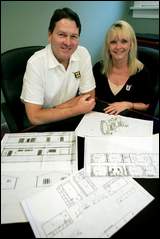Getting Some Love From The Local Press

The following article was in our local newspaper, The Tennessean:
AIDS orphans inspire volunteers
Group tries to address basic needs
Faith in Action
Even while sitting in his office in a renovated Hillsboro Village bungalow, Art Stinson's mind frequently travels to Zulu country and the mortal struggle of his beloved AIDS orphans.
"You should see them," he says, turning his laptop computer around to display a digital image of children, either orphaned by the HIV/AIDS epidemic or suffering themselves, playing soccer.
Stinson recently returned from an exploratory mission trip to South Africa. He returned to Nashville armed with information about how to apply his design-build skills to revive this orphanage. The gleam in his eyes is evidence he left a chunk of his heart back in Umzinyathi.
"We brought them the soccer ball," he says. "The only things they had to play with before were a grocery cart they rode in and a tire swing in that acacia tree."
The acacia stands in front of the primitive assembly hall of the orphanage founded by Zulu Pastor Sylvester Cele's Faith in Action group, which tries to shed spiritual light on those dwelling in AIDS' shadow.
"That building needs a lot of work," says Stinson, whose Trace Ventures specializes in home renovations and additions. It's a fulfilling profession.
But in the African bush occupied by a proud tribe under constant attack by merciless AIDS, he found a desperate need for his talents. "There was only so much Pastor Cele's group could do. They really needed our help."
Stinson is a relatively "new recruit" to the Sihawukelwe Lauren's Children's Home volunteer board, sprouted from the global missions program at Christ Church Cathedral.
The board is headed by local children's activist Sandie Griffith, who like most of her cohorts is a member of the historic Episcopal church. "But we need to get help from a lot of other people," she says.
Griffith and Stinson estimate $250,000 is needed just to seriously begin their open-ended commitment.
Beyond turning the assembly hall into a dormitory, complete with kitchen and study areas, these missionaries want to tend to the youngsters' health and education needs. More knowledge may help stem the brutal epidemic.
First things first, though: provide sanitation, nutrition and basic human needs.
Griffith made her first trip to the children's home a year ago and returned with Stinson and the others this summer. "Once you've been there, it gets in your blood."
On her first trip, the children were sleeping on a concrete floor. The board purchased bunk beds, but the kids still lack reliable electricity and water and sewers.
Griffith smiles when Stinson details how the children and the village Zulus "were so excited to see us bringing something as basic as the Port-a-Johns."
Stinson says it may take two years to complete the dormitory. In the meantime, the children's home board has seeded a cottage industry, providing funds for the locals to make jewelry and carvings that will be sold here in Nashville.
"We want them to be able to help themselves," says Griffith, noting that women from throughout the village will be participating and all profits will go to the orphanage.
Seventeen AIDS orphans live in the actual facility. Dozens more have "graduated" to foster families. The board feeds the foster families as well as the orphanage residents and caregivers.
Grim reality does cast a shadow on this endeavor of hope. Some of these orphans may die before the project is completed. The AIDS epidemic certainly will bring more residents to the orphanage.
"I'm fortunate to live relatively comfortably," muses Stinson. "I have the duty to give back. I've done things in our community. Now I see this as giving to our global community."
Griffith nods. "My faith requires me to serve people and to love people. What you get back is the ultimate joy." •
By TIM GHIANNI
Senior Writer
Published: Saturday, 09/23/06





